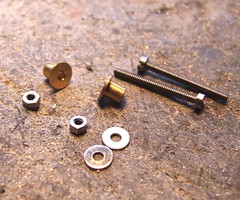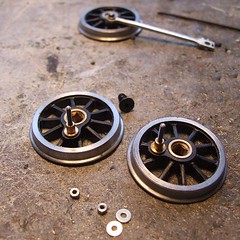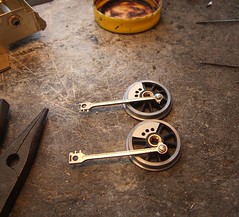 When you make the move from 4mm to 7mm, unless you've been very finescale in the smaller scale, the number of parts in a crank pin is a surprise. Romford give you a pin that screws into the face of the wheel and a thick washer to solder on the front to retain the rods.
When you make the move from 4mm to 7mm, unless you've been very finescale in the smaller scale, the number of parts in a crank pin is a surprise. Romford give you a pin that screws into the face of the wheel and a thick washer to solder on the front to retain the rods.Slaters supply a bolt to be screwed in through the back of the wheel, a brass bearing to go on the front and locate the rod, a steel washer to go over this and finally a nut to hold the whole lot together. Mechanically, this is an excellent system. Instructions are provided but I prefer to make some extra modifications in light of experience.
First, the back of the wheel is countersunk. This allows the bold head to be nearly flush with the back of the wheel. Ideally you replace the cheese head bolt with a countersunk version, why Slaters don't do this for you is a mystery to me. If the head is proud you'll normally be OK but on some models that bit of metal orbiting the axles will find something to clobber. A flush finish looks better anyway.
 I also like to put a touch of superglue on the bolt threads at the back of the wheel before finally screwing it home. This stops the bolt rotating when you try and tighten up the retaining nut. The loco frames will always be in the way of remedial action if this bolt gets loose so stopping it happening now is good planning.
I also like to put a touch of superglue on the bolt threads at the back of the wheel before finally screwing it home. This stops the bolt rotating when you try and tighten up the retaining nut. The loco frames will always be in the way of remedial action if this bolt gets loose so stopping it happening now is good planning.All that is left is to shorten the brass bearing if required - I put the bearing through the rod and file it until it is just proud. If you have two rods on the crank pin (e.g. coupling and connecting rods) then the bearing is fine as it is. Then the steel washer goes on and the nut is done up. The rods shouldn't be clamped tight with the nut - if they are you shortened the bearing too much.
All this is fine most of the time but the Garratt has very limited space behind the cross heads. I looked at this and decided that while I might be able to use the supplied set up by filing the steel nut nice and thin, there was a better way.
 The bolt was replaced with a brass version. Then the bearing was filed down as much as possible. The steel washer is then used to trap the rods as usual but the nut goes in the spares pot. This is replaced with a small brass washer soldered to the bolt (brass is easier to solder than steel, hence the replacement), much like a Romford crank pin. The soldered joint is dressed to make it smooth and the resulting part is strong. Result - fresh air between the back of the crossheads and the front of the crankpin. Not much but a miss is as good as a mile in this case.
The bolt was replaced with a brass version. Then the bearing was filed down as much as possible. The steel washer is then used to trap the rods as usual but the nut goes in the spares pot. This is replaced with a small brass washer soldered to the bolt (brass is easier to solder than steel, hence the replacement), much like a Romford crank pin. The soldered joint is dressed to make it smooth and the resulting part is strong. Result - fresh air between the back of the crossheads and the front of the crankpin. Not much but a miss is as good as a mile in this case.
No comments:
Post a Comment